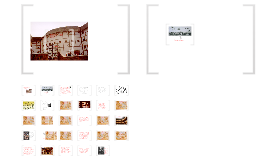Globe Presentation
Transcript: A Guided Tour A Guided Tour This portrait appeared on the cover of the First Folio -- the first publication of his plays -- in 1623. Shakespeare’s Globe Theater STAIRS: Ascending to the first level from the PIT for theatergoers to reach the galleries. Between 1586 and 1588 William Shakespeare took up residence in London, England, leaving his family behind in Stratford. He had reached some level of prominence as an actor by 1592, when he became the subject of a scathing review by Richard Greene in a piece titled “A Groatsworth of Wit.” THE HEAVENS: Area above the stage with a trap door for lowering actors and props. Ceiling was painted with the signs of the zodiac. Shakespeare’s Globe Theater TRAP DOOR: Entryway into HELL, used for ghostly comings and goings. The floor of the PIT was typically covered with nut shells, the leavings of thousands of patrons who purchased the nuts and then just dropped the shells on the ground during the shows. STAGE DOORS: Doors opening into the TIRING HOUSE from the stage TIRING HOUSE DOOR: The rear entrance for actors and privileged spectators. THE HUTS: Storage area for pulleys and area for sound effects. The Globe Theater COMPANY SIGN: Sign identifying the theater and the acting company for the patrons. These are the GALLERIES. You could purchase a seat in them for two pennies and for a little extra could also rent a cushion to put on the wooden seats. DOORWAY: Entrance from hallway into the gallery. The Globe -- called “the Wooden O” by Shakespeare -- opened in 1599 with a performance of Henry V. What follows is a pictorial tour through Shakespeare’s Globe. ROYAL (PATRON’S) BOX: The special seating area for members of the royalty or for the patron of the acting company. INNER STAGE: A recessed playing area set off by a curtain which was opened for appropriate scenes In this view the paintings on the HEAVENS are clear. The overhang helped keep the actors dry during inclement weather. HALLWAY: Allows entry to the galleries HELL: The area under the stage used for ghostly comings and goings, appropriate scenes, and storage PIT: The area immediately around and below the stafe where the Grounglings stood to view the play. GALLERY: Seating for upper class patrons (2 cents) TIRING HOUSE: The backstage area which provided space for storage and business offices. An actor by trade, Shakespeare joined The Lord Chamberlain’s Men, a renowned acting company, in 1592. By 1599 the company needed a new playhouse after being forced out of their old one and so decided to become equal partners in a new venture -- the Globe Theater. WARDROBE: The storage area for costumes. Because of laws passed by the city fathers of London, no theaters could be built within the city itself. Therefore, The Globe, like the other theaters of the day, was constructed across the river Thames in Southwark. DRESSING ROOM: Rooms where the actors were attired and waited for cues. ENTRANCE: Main Entry to the theater where admission would be collected. During a performance of Henry VIII on June 29, 1613, an over-charged cannon misfired. The wading landed on the thatch roof, setting the theater ablaze, destroying the building Shakespeare had retired from only two years earlier. The PIT or the YARD is the area at the foot of the stage reserved for the Groundlings, each of whom paid a penny to see the play. In the PIT one would also find wine and fruit sellers mingling among the patrons. The Globe Theater Between the PIT and the GALLERIES, almost 3,000 people might cram into the Globe to watch a performance. Nowadays the rebuilt Globe holds 1,500 -- 1000 in the Galleries and another 500 in the Pit. BALCONY: Located above the stage, it housed musicians or spectators and was used for special scenes FLAG: Announcing the type of performance that day -- comedy, tragedy, or history. With the ascension of James I to the throne of England in 1603, Shakespeare’s company changed patrons -- becoming The King’s Men. The Globe continued to be the building in which the company’s plays were performed, even after William Shakespeare’s retirement in 1611. From the front the stage of the Globe was designed to look rather like the front of a building. In the center was the curtained entrance into the INNER STAGE. To either side you will see the entrances into the TIRING ROOMS, doorways used during the productions for entrances and exits by actors. For example, one side for Capulets and the other for Montagues. The BALCONY above was used by Shakespeare for special scenes (Romeo and Juliet, Act II, scene ii), for the musicians, or as seating for special play-goers. The stage floor stood approximately 5 feet above the floor of the pit, allowing the actors to use the area under the stage -- HELL -- for scenes involving graves (Hamlet), for ghostly appearances (the witches’ pot in Macbeth or the ghost in Hamlet), and for characters who must decend into Hell (Marlowe’s Dr. Faustus).

















